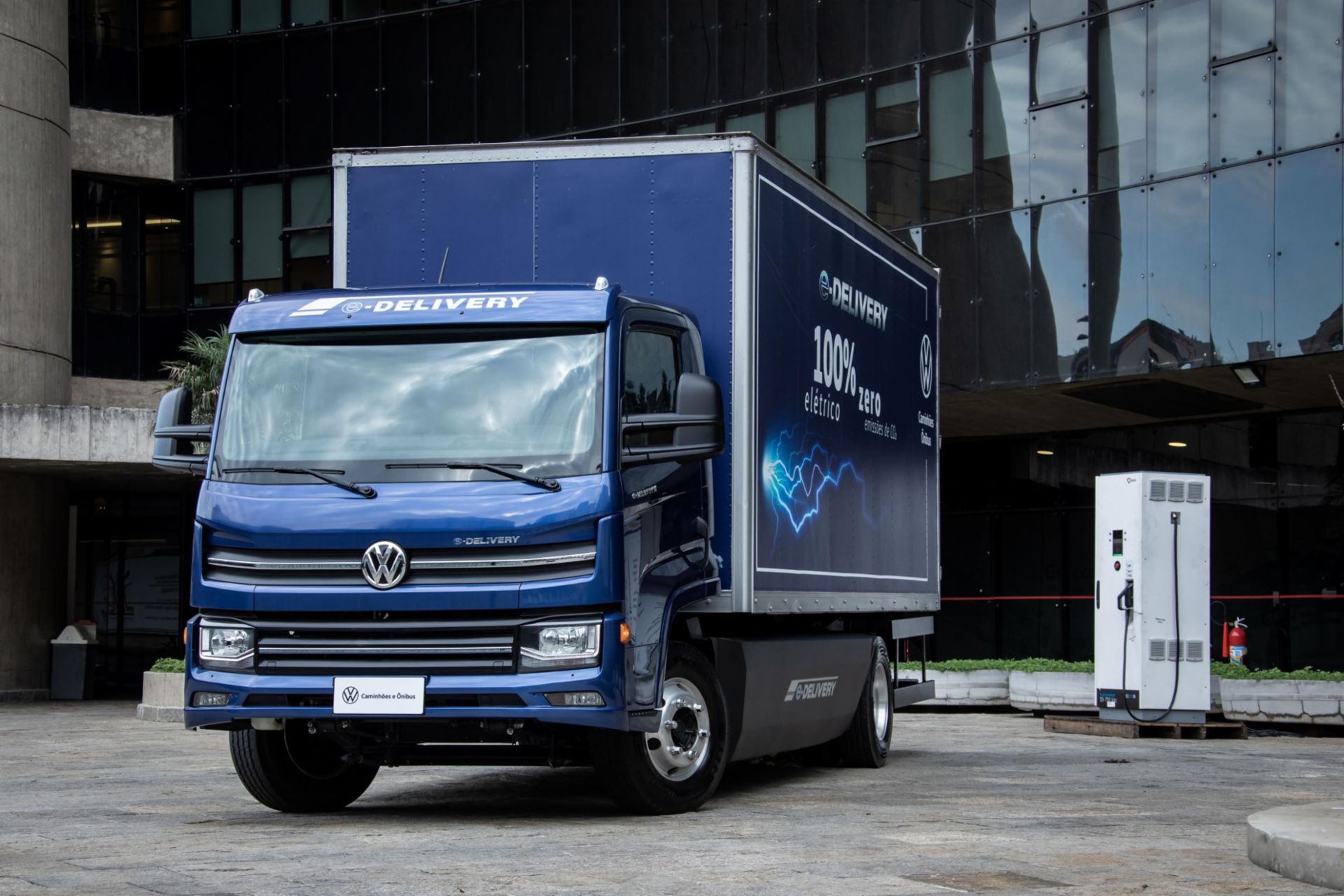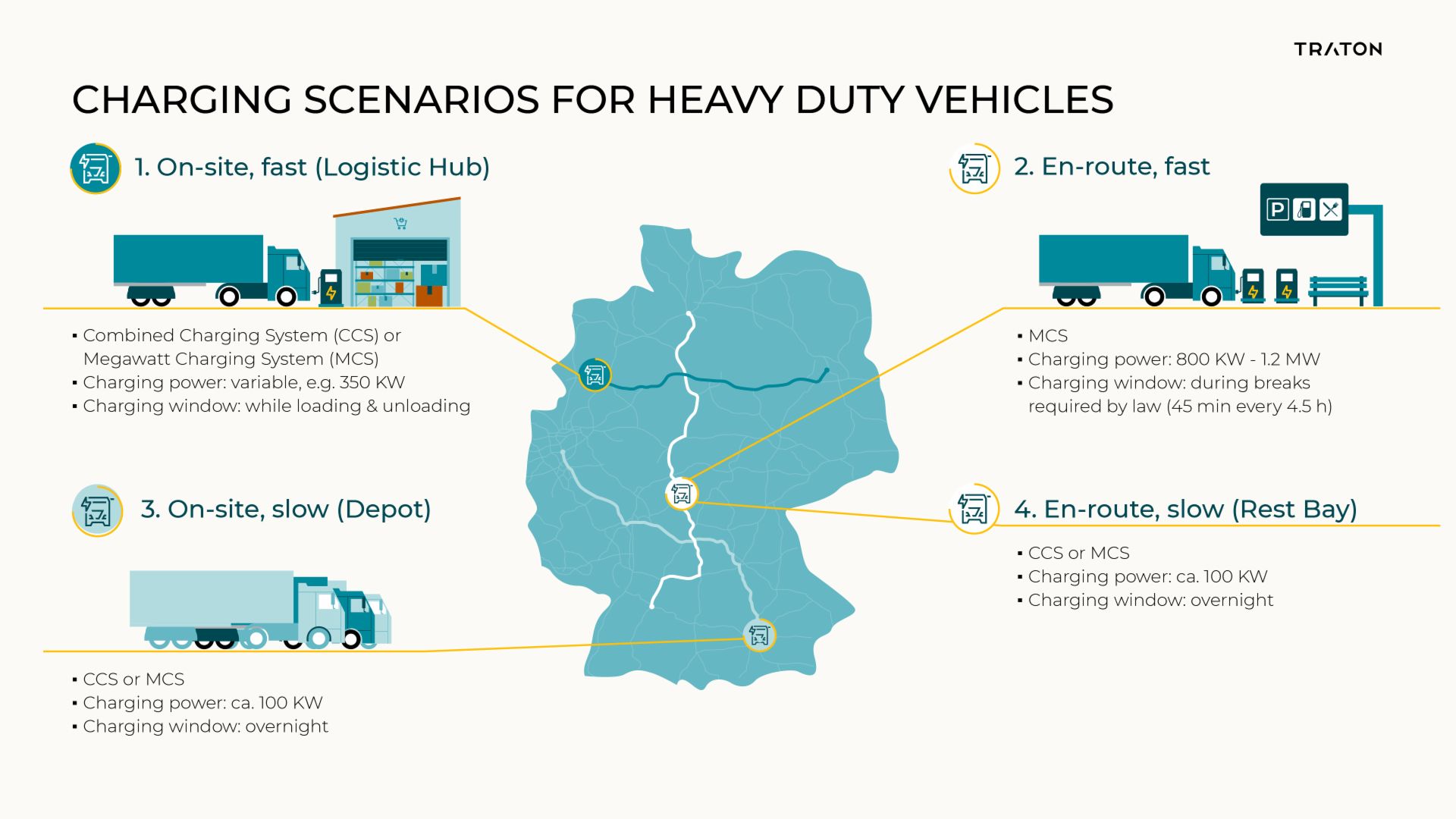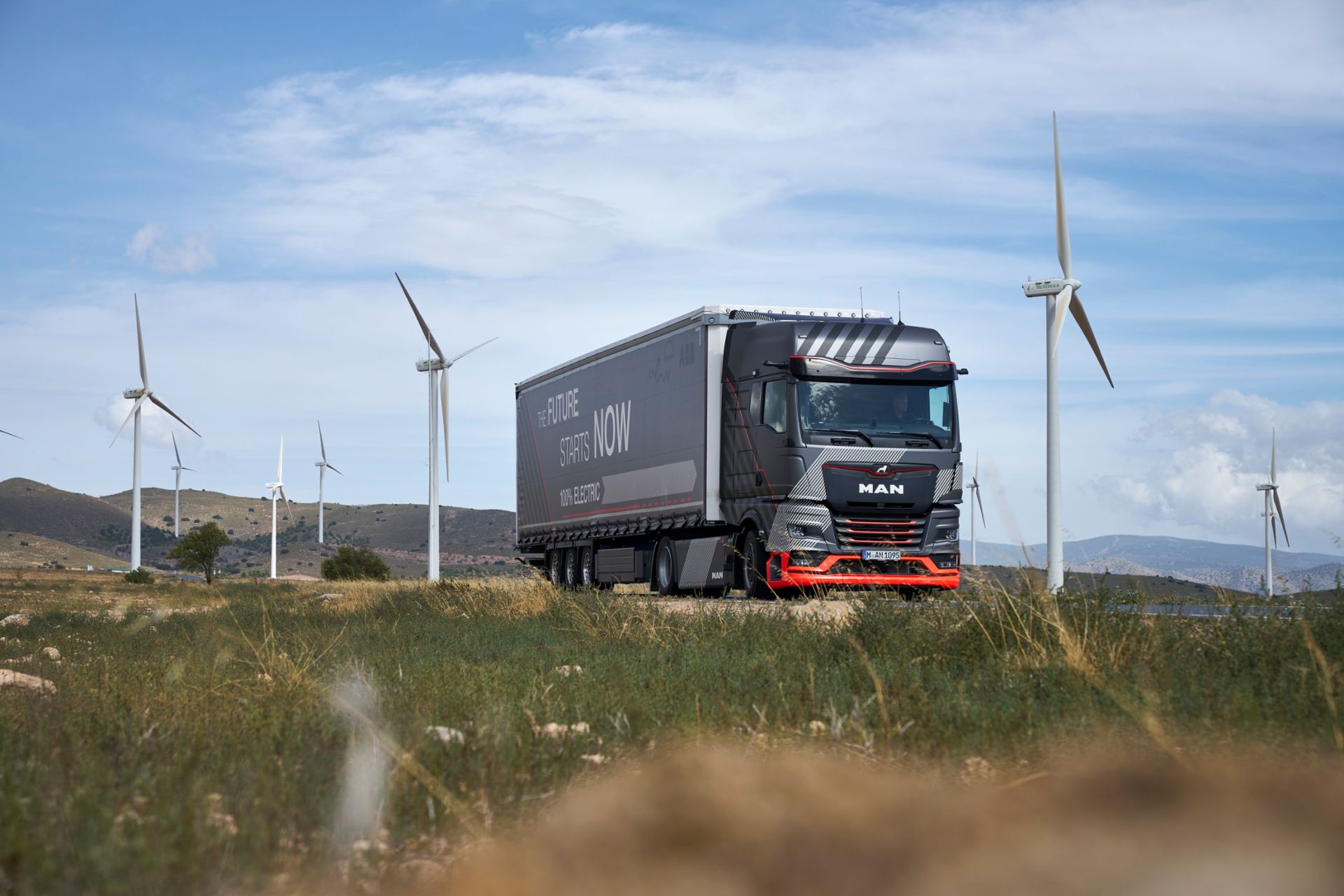The TRATON GROUP is committed to combating climate change, and the Company’s biggest contribution to this goal is the electrification of its brands’ product portfolios. Replacing just 10,000 traditional diesel trucks with battery electric commercial vehicles (BEVs) that run on green electricity enables savings of one million tons of CO₂ annually in Europe, and more in North America. TRATON is targeting around half of its annual new vehicle sales in the EU27+3 region, the U.S., and Canada to be zero-emission vehicles by 2030.
Although TRATON and its brands are supporting the transition to electrification by producing BEVs, there is a chicken-and-egg problem due to the lack of a robust, high-capacity charging network to support their energy needs. Currently, there are almost no public charging parks along long-haul routes, which means e-trucks in these operations can only be charged in depots or at their destinations, significantly limiting their daily operational range. This challenge is less about the time required for intermediate charging sessions and more about the scarcity of charging locations.
In addition, the current CCS standard leads to comparatively long charging times of one to two hours given the large battery packs in long-haul BEVs. This can have an impact on logistics and scheduling, posing challenges to operational efficiency and reliability.
MCS is a game-changing technology for long-haul BEVs
The solution to these challenges lies in implementing the Megawatt Charging System (MCS) in newly built public charging parks, equipping them with ultra-fast charging capabilities to significantly reduce charging times for long-haul BEVs. MCS technology, which can theoretically reach a charging capacity of up to 3.75 megawatts per hour, is designed to meet the unique high energy demands of BEVs.
“MCS is an upcoming standard that allows us to go for a 45-minute recharge, no longer than the mandatory rest period. This alleviates many of the most urgent needs for full-day batteries, enabling our batteries to become much smaller – and thus both cheaper and more lightweight,” says Andreas Kammel, Vice President Alternative Drivetrains in the TRATON GROUP. “It means we get the full energy cost advantage that makes the business case of long-haul trucks so great with just half, or a bit more than half, the battery size. It almost feels like cheating.”
The MCS standard does away with extended charging times or significant payload capacity reductions. As a result, it eliminates one of the primary barriers to electrifying long-haul trucks. By planning in advance for a top-up charge during their mid-day breaks, drivers and fleet operators can maintain their schedules and routes without significant downtime or negatively impacting overall operational efficiency.
The conditions required to achieve an ultra-fast charging network
However, the lack of ultra-fast MCS infrastructure means it will take time for the technology to become widespread. A dense fast-charging network will not be available for around four to six years at the earliest. Two conditions must be met: first, the charging infrastructure must be in place; second, the infrastructure must be cheap enough. However, according to Kammel, there is a misconception that the costs required are prohibitively high.
“Utilization is going to be much higher than it is for passenger cars – but unfortunately, many of those cost comparisons come from the passenger car side, ignoring the major advantages when charging trucks. These come down to the higher homogeneity of usage, higher plannability, and stronger concentration on fewer routes of trucks – all boosting utilization. With high utilization, you can use the costly bit – the grid connection – more intensively. You can even get to a point where you’re looking at adding overnight charging on top,” explains Kammel.
“When it comes to public charging, there’s also a major flexibility advantage: you can choose locations where grid access and land are cheap. This means that the actual cost is lower than a naïve average over all possible locations would suggest. This is crucial because it makes the trade-off even more worthwhile to opt for more fast-charging events instead of a larger battery,” says Kammel.
The four charging solutions available for fleet operators
- Overnight depot charging involves charging vehicles at a central facility, typically during off-peak hours.
- Public charging provides quick top-ups at strategically located stations.
- Overnight public charging takes advantage of long rest periods for slower, more complete charges.
- Destination charging allows BEVs to recharge at the endpoint of their journey, ensuring they are ready for the next trip.
E-Mobility at-a-glance
-
The C-rate (current rate) measures the rate at which a battery is charged or discharged relative to its maximum capacity. For example, a C-rate of 1C means the battery will be fully charged or discharged in one hour, while a 2C rate means the battery will be fully charged or discharged in half an hour.
-
Interoperability refers to the ability of different systems, devices, or applications to work together seamlessly. It enables different types of BEVs to seamlessly use various types of infrastructure, regardless of the manufacturer. This ensures that fleets of BEVs can utilize a wide range of charging options, enhancing operational efficiency, and reducing downtime.
-
Bi-directional charging allows BEVs to not only draw power from the grid to charge their batteries but also send stored energy back to the grid or power other devices. Vehicle-to-Grid (V2G): BEVs can supply power to the grid during peak demand periods, helping to stabilize the grid. Vehicle-to-Load (V2L): BEVs can power external devices or other vehicles, which can be useful in remote locations or emergencies.
Developing innovative charging solutions through collaboration
Collaboration is at the core of the TRATON GROUP. As well as fostering close connections between its Scania, MAN Truck & Bus, Navistar and Volkswagen Truck & Bus brands, the Company has also partnered with industry experts, and is driving innovation through selected partnerships, such as the Milence joint venture established by the TRATON GROUP, Daimler Truck, and the Volvo Group. Together, the partners are committed to establishing a network of 1,700 high-capacity public charging points in Europe by 2027, accelerating the transition to zero-emission heavy-duty vehicles.
Milence has opened its first major stations across various European countries, starting with its charging hub in Venlo, the Netherlands, in December 2023. New announcements are being made almost weekly.
“The price point of those stations has been significantly lower than many people expected. On the passenger car side, you often see something around 70 eurocents or 80 eurocents. But that first station opened at a price of 39.9 eurocents, even though the Netherlands is not a low-cost electricity country. So, our expectation is that this trend will continue,” says Kammel. “Fast-charging will not be as costly as commonly expected. And Milence, in our opinion, will be one of the most important players in getting this right.”
PACT: the unified voice for BEV infrastructure in the U.S.
January 2024 saw the launch of Powering America’s Commercial Transportation (PACT) – a coalition established by TRATON GROUP brand Navistar, Daimler Truck North America, and Volvo Group North America. PACT is focused on education and advocacy for accelerating the construction of nationwide infrastructure in the U.S. for medium- and heavy-duty zero-emission vehicles (ZEVs). It aims to overcome the many barriers delaying access to ZEV infrastructure while enhancing national climate policies to address the infrastructure needs of these vehicles.
TRATON Charging Solutions: making charging solutions accessible and affordable
To facilitate the transition of fleets to BEVs, the TRATON GROUP has also established the TRATON Charging Solutions service entity. It aims to simplify electric commercial transport by offering contracting, invoicing, and utilization insights for seamless charging experiences.
The goal of TRATON Charging Solutions is to make charging solutions accessible and affordable via a more accessible, hassle-free charging process that will make heavy-duty BEVs viable at scale. TRATON Charging Solutions mainly covers the access and billing process for fleets.

“If you have this service, you should be able to go to any charging stations and just plug in your truck and get charged. That is the idea. And you get one invoice for your complete fleet. So, this is a multi-brand service. So, it's not bound to Scania or MAN trucks, you can use other brands as well,” says Fredrik Allard, Senior Vice President and Head of E-Mobility at Scania.
TRATON Charging Solutions offers the widest network of public charging stations for trucks
- Active in 13 European countries (its goal is to become global, with 16 by the end of 2024 and the covering the whole of Europe in 2025; other parts of the world will follow afterwards)
- More than 100 planned new charging point locations in 2024
- Currently 43 charging stations suitable for trucks with 135 CCS standard (at least 350 kW) charging points
- More than 5,000 unspecified passenger car charging locations (it is still under investigation how many of these are suitable for trucks)
- Currently, Scania customers can use the services powered by TRATON Charging Solutions via the branded service Scania Charging Access
- More than 30 customers are using Scania Charging Access, with more than 120 active RFID cards
- More than 1,100 charging sessions have been undertaken since its launch in October 2023
- Later this year, MAN will announce its own charging service powered by TRATON Charging Solutions later this year (aligned with first deliveries of the MAN eTruck)
Further information regarding current developments in the battery electric commercial vehicle market can be found here.





